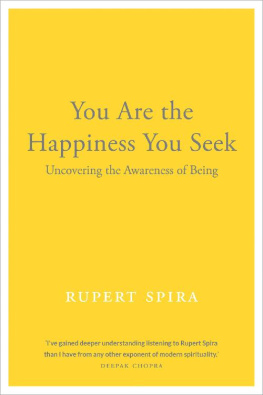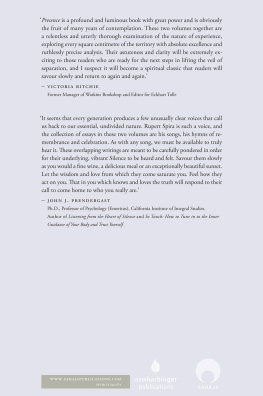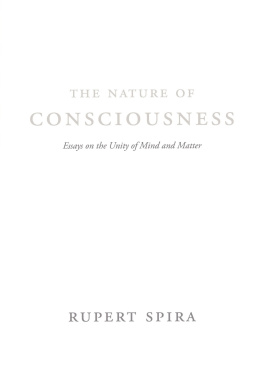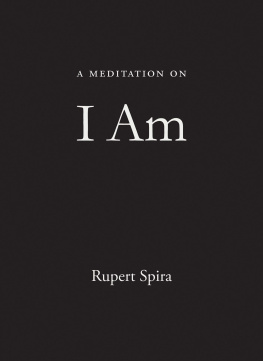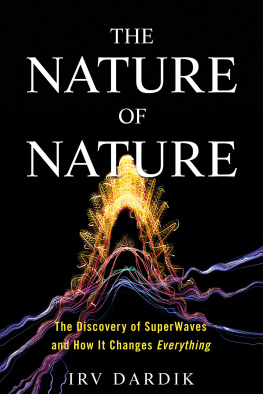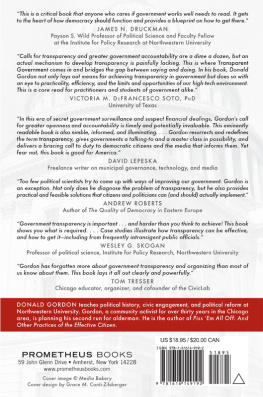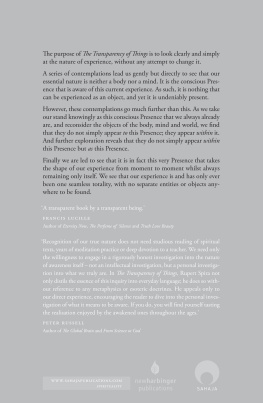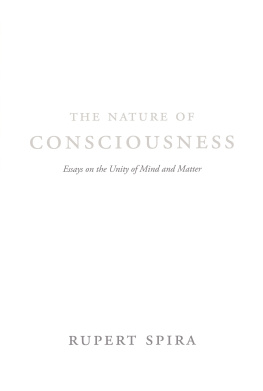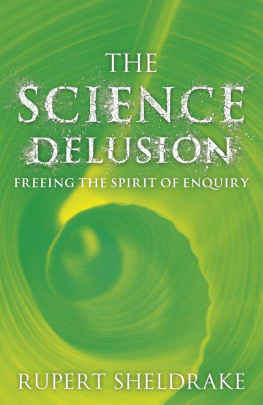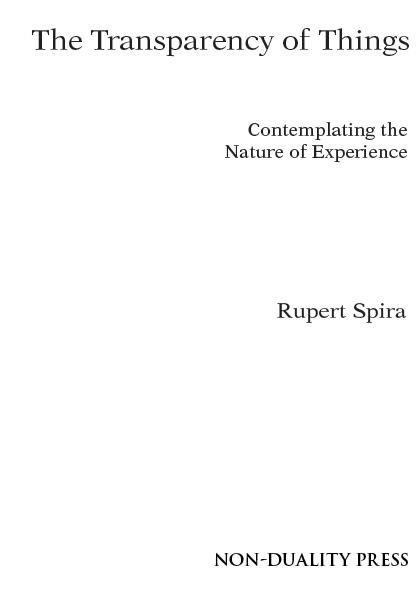
First paperback edition published November 2008 by Non-Duality Press
Rupert Spira 2008, 2012
Rupert Spira has asserted his right under the Copyright, Designs and Patents
Act, 1988, to be identified as author of this work.
All rights reserved.
No part of this book may be reproduced or utilised in any form or by any means, electronic or mechanical, without prior permission in writing from the Publishers.
Cover design by Rupert Spira and John Gustard
Cover photograph by Caroline Seymour
Non-Duality Press, Salisbury, SP2 8JP
United Kingdom

Ebook ISBN 978-1-908664-11-2
Paperback ISBN 978-0-9558290-5-5
www.non-dualitypress.org
This book is written with gratitude and love for Ellen, my companion, and Francis Lucille, my friend and teacher.
That which is, never ceases to be. That which is not, never comes into being.
PARMENIDES
Foreword
This book is a collection of contemplations and conversations about the nature of experience. Its only purpose, if it can be said to have any purpose at all, is to look clearly and simply at experience itself.
The conventional formulations of our experience are, in most cases, considered to be so absolutely true as to need no further investigation. Here, the opposite is the case. Absolutely nothing is taken for granted, save the conventions of language that enable us to communicate.
From an early age we are encouraged to formulate our experience in ways that seem to express and validate it, and these expressions subsequently condition the way the world appears.
David loves Jane, Tim saw the bus. Our earliest formulations divide experience into I and other, me and the world, a subject experiencing an object. From that time on, our experience seems to validate these formulations.
However, at a certain stage it begins to dawn on us that these formulations do not express our experience, but rather they condition it.
This book does not address the particular qualities of experience itself. It explores only its fundamental nature. What is this I? What is this other, this world? And what is this experiencing that seems to join the two together?
The essential discovery of all the great spiritual traditions is the identity of Consciousness and Reality, the discovery that the fundamental nature of each one of us is identical with the fundamental nature of the universe.
This has been expressed in many different ways. Atman equals Brahman. I and my Father are one. Nirvana equals Samsara. Emptiness is Form. I am That. Consciousness is All. There are not two things. Sat Chit Ananda.
Every spiritual tradition has its own means of coming to this understanding, which is not just an intellectual understanding, but rather a Knowingness that is beyond the mind. And within each tradition itself there are as many variations on each approach as there are students.
This book explores what it is that is truly experienced. What is the nature of our experience in this moment? is the question that is returned to again and again.
However, this is not a philosophical treatise. It is a collection of contemplations and conversations in which a few core ideas are explored over and over again, each time from a slightly different angle, and for this reason there is an inevitable element of repetition.
In some ways this book is written like a piece of music in which a single theme is explored, questioned, modulated and restated. However, each time the central theme is returned to, it will, hopefully, have gathered depth and resonance due to the preceding contemplation.
The meaning of the words is not in the words themselves. Their meaning is in the contemplation from which they arise and to which they point. The text, therefore, is laid out with lots of space in order to encourage a contemplative approach.
Having said that, the conclusions drawn are only meant to uproot the old, conventional and dualistic formulations that have become so deeply embedded in the way we seem to experience ourselves and the world.
Once these old formulations have been uprooted, they do not need to be abandoned. They can still be used as provisional ideas that have a function to play in certain aspects of life.
The new formulations are perhaps closer or more accurate expressions of our experience than the old ones, but their purpose is not to replace the old certainties with new ones.
They simply lead to an open Unknowingness, which can be formulated from moment to moment in response to a given situation, including a question about the nature of experience.
There are many ways to come to this open Unknowingness, and the dismantling of our false certainties through investigation is just one of them that is offered here.

If our attention were now to be drawn to the white paper on which these words are written, we would experience the uncanny sensation of suddenly becoming aware of something that we simultaneously realise is so obvious as to require no mention. And yet at the moment when the paper is indicated, we seem to experience something new.
We have the strangely familiar experience of becoming aware of something which we were in fact already aware of. We become aware of being aware of the paper.
The paper is not a new experience that is created by this indication. However, our awareness of the paper seems to be a new experience.
Now what about the awareness itself, which is aware of the paper? Is it not always present behind and within every experience, just as the paper is present behind and within the words on this page?
And when our attention is drawn to it, do we not have the same strange feeling of having been made aware of something that we were in fact always aware of, but had not noticed?
Is this awareness not the most intimate and obvious fact of our experience, essential to and yet independent of the particular qualities of each experience itself, in the same way that the paper is the most obvious fact of this page, essential to and yet independent of each word?
Is this awareness itself not the support and the substance of every experience in the same way that the paper is the support and the substance of every word?
Does anything new need to be added to this page in order to see the paper? Does anything new need to be added to this current experience in order to become aware of the awareness that is its support and substance?
When we return to the words, having noticed the paper, do we lose sight of the paper? Do we not now see the two, the apparent two, simultaneously as one? And did we not always already experience them as one, without realising it?
Likewise, having noticed the awareness behind and within each experience, do we lose sight of that awareness when we return the focus of our attention to the objective aspect of experience? Do we not now see the two, the apparent two, Awareness and its object, simultaneously as one? And has it not always been so?
Do the words themselves affect the paper? Does it matter to the paper what is said in the words? Does the content of each experience affect the awareness in which it appears?
Every word on this page is in fact only made of paper. It only expresses the nature of the paper, although it may describe the moon.
Every experience only expresses Awareness or Consciousness, although experience itself is infinitely varied.
Next page

